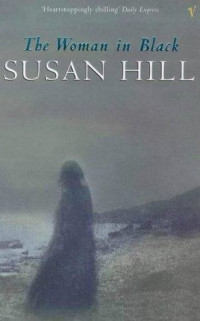1. Summary of the content
Arthur Kipps is a young solicitor who works in London. One day he is sent to a village in the countryside, Crythin Gifford to sort out the papers of Mrs. Drablow, an old woman who recently passed away. After his arrival he goes to her funeral. Here he sees a very vague and sick woman. She is later described as The Woman In Black.
The day afterwards Arthur is brought to Mrs. Drablow’s villa, Eel Marsh House by a Keckwick, the caretaker of the area. Here again he sees the Woman in Black and his fear begins to rise. Ignoring these emotions he settles in the house for his work. When he goes outside for a small interval mist suddenly surrounds him and then he hears the sounds of a pony and trap falling into the water and a child drowning to death. He goes back to the house and falls into an uncomfortable sleep. At midnight he is awoken by Keckwick who decided to pick him up. Back in Crythin Grifford he writes a letter to his boss and his girl friend.
The following day Arthur Kipps goes back to Eel Marsh House, this time with the company of a dog. He starts working on the papers again. At night he is awoken by continuous noises coming from the nursery. He wants to investigate but the door was locked.
The next morning he is again disturbed by the drowning noises he had heard a couple of days earlier. He figures all these strange noises and sightings of a woman have got something to do with ghosts and he decides to check the nursery again. The door is open now and Arthur could see the source of the noise of the last night: a rocking chair. At night, while Arthur is walking the dog he hears a ghostly whistle. His pet rushes to where the noise comes from: into the marsh. After a struggle Arthur miraculously saves him. Back in the house he visits the nursery where everything is in state of disarray.
Finally, Arthur’s new friend Samuel tells him the whole story about the so-called Woman in Black. She haunts the place and kills new-born children because during her lifetime her child was killed. Arthur decides to send all the work he’s done to his boss and goes back as quickly as possible home to London.
After a couple of years he and his girlfriend have a baby. When it turns one year old the Woman in Black killed him in front of Arthur’s eyes.
2. More detailed analysis of the book
- The title of the book is very clear. It’s the name the citizens of Crythin Grifford have given to the mysterious ghost of Eel Marsh House who is also, next to the main character Arthur Kipps, the centre of the story.
- ‘The Woman in Black’ is a ghost story as it is based on a ghost and as there are many scary, inexplicable things that happen in the novel.
- There is no real clear theme or morale in this book, as you would find in for example a detective novel (crime doesn’t pay). However, after studying the book more carefully, you could state that the theme is ‘endless revenge’. This is because the ghost used to be a woman who lost her baby and therefore continuously kills little offspring of other people, including the main character Arthur Kipps.
- The characters are
Arthur Kipps: He is the main character. He is a solicitor. At the beginning he didn’t believe in ghost or any ‘fantasy’ figures but after his encounter with the woman in black he does. This turns him into a silent man.
The woman in black: she is the ghost that Arthur keeps on meeting or hearing. She haunts the Crythin Grifford looking for baby’s to kill. This she does in order to revenge the loss of her baby.
Samuel Daily: He is a rich and friendly man who becomes a friend of Arthur as the story progresses. Eventually he lends Arthur the dog spike to accompany him in the haunted house.
Stella She is Arthur’s girlfriend. In the story she plays no significant role other then replying to letters of Arthur and picking him up from Crythin Grifford.
Mr. Jerome: He is a lawyer in Crythin Grifford. His life has been turned around because the woman in black killed his baby. He is a silent man who is supposed to help Arthur but stays in the background.
Keckwick: He is the caretaker of Eel Marsh House and the land around it. He is a man that doesn’t talk a lot but is very helpful to Arthur. In his pony and trap he transports Arthur to and from the house.
- The story takes place in the second half of the 19th century. It doesn’t say so in the book but you can conclude that it’s this time period due to the characters, events and description of things.
- The narrator is the main character himself, Arthur Kipps. The introduction tells the reader that Arthur wants to write down what happened to him at Eel Marsh House to exorcise the ghost that is still hindering him.
- The main story takes place in Crythin Grifford, a small isolated village in the country side of England. The other setting is London but only the beginning of the novel is situated here, when Arthur Kipps is told to go to Crythin Grifford.
3. Personal Response
- I think ‘The Woman in Black’ is an enjoyable, quick read. Consisting of only 128 pages it is easy to handle for most readers, whether native English speakers or not. It is a very exciting novel because from the moment Arthur Kipps comes to Crything Grifford there are continuous moments of tension that flow into each other. This got me hooked to reading the book and wanting to know more, especially the one question: Who is the woman in black?
Furthermore it’s a well-written book; I felt as if I was part of the main character.
I would recommend this book to everyone from the age of 14 because it’s worth reading, as you’ll find out from the moment you turn the first page!
- The passage that impressed me the most:
‘I looked directly at her and she at me. There was no mistake. My eyes were not deceiving me. It was she, the woman in black. I simply stared in incredulity and astonishment, then in cold fear. I was paralysed, rooted to the spot on which I stood, and all the world went dark around me and the shouts and happy cries of all the children faded. I was quite unable to take my eyes away from her. There was no expression on her face and yet I felt all over again the renewed power emanating from her, the malevolence and hatred and passionate bitterness. It pierced me through.’
This is the passage that impressed me most because it’s the final climax. This passage is written on the final page of the book. Arthur Kipps had almost forgotten the woman in black; he had put that chapter of his life behind him. He was now a proud father. Yet at the moment that he is back to full strength he meets his old fear once again. I enjoy the way Susan Hill describes this event using Arthur Kipps thoughts, eyes and ears at that split second.
After this the Woman in Black kills Arthur’s baby.
- At first the main character doesn’t have any real problems. He is a happy young man. But slowly on in the story a problem arises. That problem is the Woman in Black. In the end she changes Arthur Kipps completely to a more adult, silent man. This problem he tries to solve, as explained in the introduction, by writing his whole experience down on paper.
I would probably have handled this extraordinary problem in a similar way. I would have written down the whole event and shared it with people to lessen my pain. Next to that I would have tried to find something like a hobby or sport to keep me busy and forget about the depressing experience.
- ‘The Woman in Black’ was first published in Great Britain in1983 by Hamish Hamilton. Even though this story has been written quite recently I believe that it should be categorised under 19th century ghost stories. Therefore it’s part of the Victorian period (1830-1901).
The writing styles of this period are from biting social satire, horror, and adventure. These were the days of writers such as Charles Dickens, Mark Twain and Victor Hugo.
Other things that characterised this time are Industrialism, the Woman Question and painterly Images in poetry.
This period was of course named after Queen Victoria who was the daughter of Edward, the Duke of Kent and Princess Victoria of Saxe-Coburg. She was born in Kensington Palace in London on May 24th, 1819 and died in 1901.
Victoria's long reign witnessed an evolution in English politics and the expansion of the British Empire, as well as political and social reforms on the continent. France had known two dynasties and embraced Republicanism, Spain had seen three monarchs and both Italy and Germany had united their separate principalities into national coalitions.
Even in her dotage, Victoria maintained a youthful energy and optimism that infected the English population as a whole.
The national pride connected with the name of Victoria - the term Victorian England, for example, stemmed from the Queen's ethics and personal tastes, which generally reflected those of the middle class.
Susan Hill has tried to make this a Victorian novel by setting the story in this era. However this is the only reason that it’s a Victorian novel. As it takes place in an isolated city it’s hard to spot other Victorian elements in this story. It does not, for example, talk about industrialism or queen Victoria.







REACTIES
1 seconde geleden